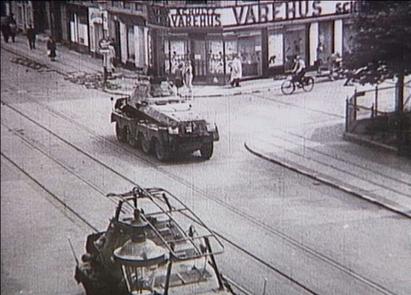
German occupation (1940-1945)
Here is a short summary of the German occupation of Denmark:
DENMARK IS OCCUPIED
On the morning of 9 April 1940 Denmark was attacked by Germany. There was sporadic fighting between the Danish and German armies. However, the government in Copenhagen decided that the German military superiority was too great to justify further resistance. At the same time heavy bombardment of the Danish cities and towns was feared. Therefore after only a few hours it was decided to surrender. Denmark thus became an occupied country controlled by Nazi Germany.
COOPERATION WITH GERMANY
The Danish government then began to cooperate with the German occupiers. The political leaders’ strategy was to preserve as much self-determination as possible for Denmark whilst still accommodating the wishes of the Germans. In pursuing this course the large Danish political parties also sought to protect Danish society from harsh measures which might be introduced by the occupiers and from the Danish Nazis (the National Socialist Workers’ Party of Denmark).
DAILY LIFE CONTINUES
One consequence of the policy of cooperation was that most Danes could continue their daily lives much as before the German occupation. Eventually, however, the war meant shortages of goods, rationing, air-raid warnings, blackouts and closed national borders. However, although there were shortages of certain goods in Denmark, the Danes had one of the highest standards of living in Europe during the war years.
RESISTANCE
Even if most Danes supported the strategy of their political leaders, active resistance against the Germans and the policy of collaboration emerged, and became increasingly popular. The resistance movement was involved in an illegal press and carrying out sabotage operations. Such operations involved the destruction of German property, railways and companies that cooperated with the Germans.
THE MOOD CHANGES
During the course of 1943, however, the mood began to change amongst Danish population. Over the summer, as people heard about various German military defeats, numerous fights erupted between young Danes and German soldiers. Meanwhile, the resistance movement added to the turbulence with sabotage activities. In August the situation exploded with strikes taking place in Odense and Esbjerg, which then spread to many other towns. The workers at large workplaces lead the way, and soon there was large-scale unrest involving demonstrations and street battles with the Germans and Danish authorities.
THE END OF THE DANISH GOVERNMENT
To stop the August unrest the Germans demanded that the Danish government should impose the death penalty for sabotage. The government refused to agree to this. Therefore, the German occupiers imposed a state of emergency and on 29 August 1943 the government ceased to function. Meanwhile the Germans disarmed the Danish army and also tried to take over the navy. This led to fighting between Danish and German soldiers and the Danish navy sinking several vessels to prevent them falling into German hands.
INCREASED RESISTANCE AND GERMAN REPRESSION
After the August unrest the situation in Denmark was characterised by increased German repression. Arrests and executions became more common. The German occupiers used such repression in order to maintain control in Denmark and to respond to the sabotage activities of the resistance movement. Another consequence of the increase in German repression was the persecution of the Danish Jews. In October 1943 the German police were deployed to arrest the Jews, so that they could be sent to concentration camps. However, in a unique rescue operation more than 7000 Danish Jews were helped to neutral Sweden, where they could live in safety for the rest of the war. 485 Danish Jews were arrested though, and then sent to the concentration camp at Theresienstadt in Czechoslovakia.
THE FINAL PHASE OF GERMAN OCCUPATION
In the summer of 1944 sabotage operations were carried out in the Copenhagen area, and strikes and civil unrest broke out in Denmark. On 19 September 1944 the Germans dissolved the Danish police, which was seen as a potential military threat. By 1945 Denmark was a run-down country characterised by shortages of goods, fear and conflict.
LIBERATION
On 4 May 1945 at 20.35 it was announced on British radio that the German troops in Holland, North-West Germany and Denmark had surrendered. This was without a single English, American or Russian soldier setting foot on Danish soil. The period of occupation thus ended reasonably peacefully, and in most places people could take to the streets and celebrate the new freedom. An exception to this, however, was the island of Bornholm, which was subjected to heavy Soviet bombardment at the time of Denmark’s liberation.
Soldiers and seamen
Database (in Danish) of Danish seamen and soldiers in military service with the allies.
The German occupation of Denmark
You can visit the Frøslev Camp Museum, if you wish to experience the period of German occupation first hand.



